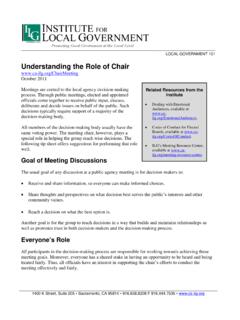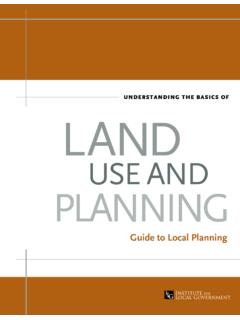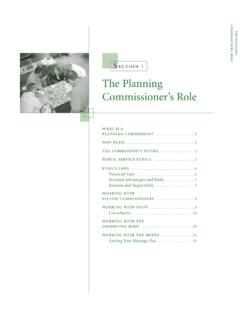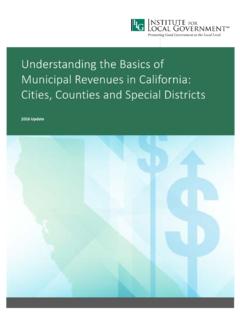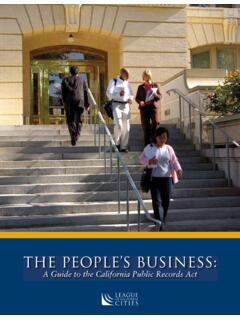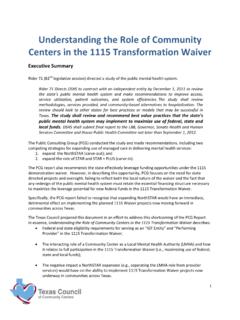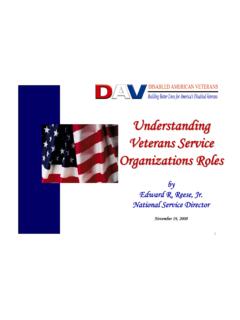Transcription of Understanding the Role of Chair - Institute for Local ...
1 Local GOVERNMENT 101 1400 K Street, Suite 205 Sacramento, CA 95814 F Resources to Further Understand Meeting Managemente Companion pieces to this tip sheet are available online: Dealing with Emotional Audiences Codes of Conduct for Elected Boards Visit our website at: Understanding the Role of Chair Meetings are central to the Local agency decision-making process. Through public meetings, elected and appointed officials come together to receive public input, discuss, deliberate and decide issues on behalf of the public. Such decisions typically require support of a majority of the decision-making body. All members of the decision-making body usually have the same voting power. The meeting Chair , however, plays a special role in helping the group reach wise decisions. The following tip sheet offers suggestions for performing that role well. Goal of Meeting Discussions The usual goal of any discussion at a public agency meeting is for decision-makers to: Receive and share information, so everyone can make informed choices Share thoughts and perspectives on what decision best serves the public s interests and other community values Reach a decision on what the best option is Another goal is for the group to reach decisions in a way that builds and maintains relationships as well as promotes trust in both decision-makers and the decision-making process.
2 Everyone s Role All participants in the decision-making process are responsible for working towards achieving these meeting goals. Moreover, everyone has a shared stake in having an opportunity to be heard and being treated fairly. Thus, all officials have an interest in supporting the Chair s efforts to conduct the meeting effectively and fairly. Tips on Chairing Meetings 2011 Institute for Local Government 2 The Chair s Role The Chair s role includes: Helping the group determine whether it has all the information necessary and available to make a decision Where there are multiple points of view on what the best decision might be, encouraging decision-makers to share those views Actively listening to determine potential points of agreement and testing those points for actual agreement Managing any conflicts that may arise during the discussions Keeping the discussion on topic Ensuring that clear decisions are made Sticking to the agenda Getting through the agenda items in a timely manner.
3 As a result, the role of the Chair can be understood as: A team captain who leads by example and helps the group function as a team; A coach who encourages participants to perform at their best, including as it relates to principles of fair play and sportsmanship; and A referee who has authority to stop the action and apply the rules of For the Chair to play the role of referee effectively, the Chair needs the group s trust and respect. To earn this trust and respect, the Chair needs to conduct the meeting fairly. This means applying the group s agreed upon standards in an impartial manner. If one s colleagues understand that the Chair s goal is to be an impartial facilitator to help the group achieve consensus, the group will be more inclined to act in ways that support the Chair s efforts and achieve the meeting s goals. To achieve both the perception and the reality of impartiality, it can be helpful for the Chair to hold off expressing his or her views on a matter and not engage in debate.
4 Strategies for Success At The Beginning of the Meeting Welcome and Introductions. It can be helpful for the public (particularly first-timers) to know who is sitting at the dais, what opportunities there will be to provide input, and how they can understand what is going on (for example, if translation equipment/service is available, where people can pick up the equipment). This can communicate decision-makers earnest desire to both receive public input and have the public understand what is going on. Tips on Chairing Meetings 2011 Institute for Local Government 3 Agenda Overview. A brief statement of the major sections of the agenda can remind both decision-makers and the public of the scope of what needs to be accomplished during the meeting. Aspirational Statement on Decorum. If the body has adopted a guidelines and goals for civility, a brief reminder to that effect can help set the tone for both decision-makers interactions and encouragement for other meeting participants conduct.
5 As the Body Moves to New Agenda Sections/Items Agenda Sections. Different agenda sections are sometimes subject to different procedures. For example, a consent agenda usually is a group of items that are routine and non-controversial and are taken up as a group. Conversely, other items are taken up one by one. Sometimes certain items are subject to special procedures (for example, public hearings). It can be helpful for the Chair to briefly note these differences, as a reminder to new decision-makers and first time attenders at the meeting. Example: Chair : Now we are at the public hearing portion of the agenda. To be respectful of the rights and interests of all involved, there will be three stages to our consideration of each item: 1. Facts and Evidence: a. First staff will summarize their analysis of the issue before us. b. Then, the applicant will be given a chance to explain, based on facts and evidence, how the applicant has met standards necessary for us to approve the application.
6 C. Next the public will be given an opportunity to offer their thoughts and evidence on the merits of the application. This can include any suggestions or questions that the public thinks we should ask of the applicant. d. We will then ask any questions of the applicant. 2. Law and Analysis a. After listening and considering both the applicant s and the public s information, it becomes our turn to discuss among ourselves what we have learned based on what has been presented. b. Once it appears that a consensus is developing, we may ask questions of staff on what kinds of findings need to be made to explain our decision based on the information we have received. Tips on Chairing Meetings 2011 Institute for Local Government 4 3. Decision a. The Chair will entertain a motion to make a decision and adopt findings consistent with that decision. b. If the motion receives a second, we ll vote to see if a majority of us can agree. Being Clear on the Issue to Be Resolved.
7 In addition to calling the agenda item, it can be helpful to identify the issue to be resolved. Chair : The issue before us is whether the application to engage in X enterprise meets the standards in our zoning code for such activities. This reminds staff, decision-makers, the applicant and the public the standard which needs to be focused on. In addition, for complex or divisive items, sometimes participants can lose sight of the issue to be decided. A helpful role the Chair can play in getting the discussion to a point of resolution is to remind participants of the issue to be resolved (or ask staff to state the issue to be resolved). Note about Technical Language. Public agency decisions sometimes involve special terminology, jargon and acronyms. This can lead to confusion and misunderstanding, which in turn, can take the discussion in unproductive directions. Another important role of the Chair is to make sure the conversation occurs at a level that everyone can understand.
8 The Chair can ask speakers to define unfamiliar terms and explain unfamiliar concepts. Fostering Discussion and Decision Opening Up the Issue for Discussion. Having stated the issue and heard staff and the public s information on it, ask for decision-makers thoughts. To enable the Chair to be a fair guider of the discussion, the Chair will typically refrain from offering their thoughts at the beginning. Who Speaks When and to Whom. At this point in the meeting, the discussion is among decision-makers and therefore decision-makers should be speaking to each other in an effort to come to a decision, not the public. When Consensus Is Not Immediately Forthcoming If the conversation does not seem to be coalescing into a consensus or even a majority position, one technique for non-time sensitive matters is to refer the matter back to staff for further work. Staff will then have time to craft a decision that endeavors to take into account as many of the concerns expressed as possible.
9 Tips on Chairing Meetings 2011 Institute for Local Government 5 An important role of the Chair is to make sure only one person speaks at a time, so both the public and decision-makers can understand and follow the discussion. A typical approach is for each decision-maker to offer their thoughts and then listen to other decision-makers thoughts in turn. If it appears multiple people want to talk at once, the Chair has the option of asking people to raise their hands to be recognized before speaking. The Chair can keep a list of who has asked to be heard, to call on each person to speak in sequence. Everyone who wants to speak should know that they are on the list and their turn is coming. Keeping Discussion Participation Balanced. Some bodies have a norm that each person will take a turn in asking all their questions and sharing their thoughts. Others find that such a restriction interferes with dialogue and the deliberative process. If a person seems to be repeating him or herself or otherwise dominating the discussion to the exclusion of others, one approach is for the Chair to acknowledge that the individual s perspective has been heard.
10 Example: Chair We have heard that Supervisor Nasirian feels strongly that fixing our roads is an urgent priority. What are others thoughts? or Is there anyone who hasn t spoken yet who would like to share their thoughts? The Chair can also give preference to those who haven t spoken. Example: Chair I see your hand up Council Member Cooke and we ll get to you in a moment; I am going to recognize Council Member Suarez first since she hasn t yet spoken. Avoiding Interrupting One Another. When people are passionate or otherwise convinced of the correctness of their position or information, they will sometimes jump in to respond to what a colleague is saying. A Chair s role is to intervene to protect the person s ability to finish their thought. ( Let s let Director Feliciano finish his thought; you ll have an opportunity to share your perspectives. ) Staff Can Be A Resource Depending on the nature of the topic under discussion, agency staff and legal counsel can sometimes assist the Chair in listening for consensus or clarifying misunderstandings that are impeding the effort to reach consensus.
